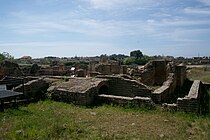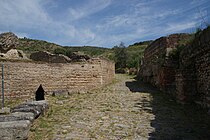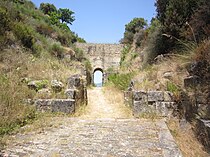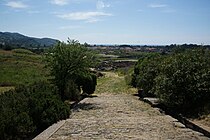 Elea - Velia: overview of the archaeological site | ||
| Elea - Velia (Ελέα) | ||
| region | Campania | |
|---|---|---|
| Residents | unknown | |
| no value for residents on Wikidata: | ||
| height | unknown | |
| no value for height on Wikidata: | ||
| no tourist info on Wikidata: | ||
| location | ||
| ||
Elea - Velia is an archaeological site at Ascea in the southern Italian province Campania. The city in "Magna Graecia" was the seat of well-known schools of philosophy.
background
On a plain and on a ridge above the beach of Marina di Ascea lie the ruins of the ancient Greek city of Elea, which in ancient times was mainly known for its philosophy schools.
In the Middle Ages, the settlement area was reduced to the mountain ridge, the Acropolis. From the time of the fight against the Saracens the name "Castellum Veliae" is known for the location, the settlement around the fortress is known as 1113 "Castellamare della Bruca" notarized. The Cappella palatina (San Quirino) has been preserved from Norman times, the fortress with the striking round tower was built over the ruins of the Greek temple. Until the 17th century the settlement was still inhabited and then fell into disrepair, François Lenoirmont The credit is attributed to having identified the ancient Elea in the ruins of Castellamare, he had traveled to Lucania around 1866. At the beginning of the 20th century excavation work began and the remains of the medieval settlement were removed. With EU funds, the 1988 became the World heritage declared archaeological site in 2000/2006 made more attractive to visitors and an antiquarium set up.
history
Around 540 BC. was made by Greeks from Asia Minor Phocaea (Φώκαια, lat. Phocaea) who fled the threat from the Persians left the city Hylea (Ύέλην) founded. The land, a ridge with the depression in the east, had been bought by the local Oenotrians. Later the name (which was originally written with the archaic letter Digamma (Ϝέλη)) changes to Ele (Ελέν) resp. Elea (Ελέαν) or, among the Romans, into the one that is easier to pronounce Velia.
In the 5th century was born in Elea Parmenides a presocratic one Philosophy School founded and by the famous student Zeno expanded, here the philosophical foundations of being were discussed. A medical and philosophical educational institution later developed from the philosophy school.
In the 4th century was the city from the advancing ones Lucanians threatened, but was able to maintain its independence for the time being. But in the Punic Wars it took the side of Rome and put galleys. In the year 88 BC. the city was called Velia incorporated into the Roman Empire, but was allowed to retain the Greek language and culture. The port used by the military gained in importance until the building of the Via Popilia the peninsula was cut off from Rome to the south and the surroundings of the city became the hinterland. With the increasing silting up of the ports - as in Paestum - the decline began and the population increasingly withdrew to the area of the Acropolis.
getting there
By plane
The nearest international airport is the Naples airport(IATA: NAP).
By train
From Napoli Centrale can the 1 Train station in nearby Ascea with the regional train Trenitalia above Agropoli can be reached within an hour and a half without changing trains.
By bus
There is a bus connection from the train station Ascea above "Scavi Velia" to Casalvelino Marina.
In the street
From the autobahn ![]() Salerno - Reggio di Calabria is used from the
Salerno - Reggio di Calabria is used from the ![]() Battipaglia the one leading south
Battipaglia the one leading south ![]() . The well-developed main road leads to the archaeological site of Paestum passing direction Agropoli. The old one runs just before the place
. The well-developed main road leads to the archaeological site of Paestum passing direction Agropoli. The old one runs just before the place ![]() through the hills of the Cilento via Ogliastro-Silento further south, the modern partly developed as an expressway
through the hills of the Cilento via Ogliastro-Silento further south, the modern partly developed as an expressway ![]() runs as a tangent along the town and continues inland to Sapri in the southeast of the Cilento, the bends from it
runs as a tangent along the town and continues inland to Sapri in the southeast of the Cilento, the bends from it ![]() south towards the archaeological site of Elea-Velia, Ascea and Palinuro. There are large parking spaces on the street, but you can also park directly after the railway underpass at the archaeological site.
south towards the archaeological site of Elea-Velia, Ascea and Palinuro. There are large parking spaces on the street, but you can also park directly after the railway underpass at the archaeological site.
By boat
The nearest international ferry port is that of Naples, in Salerno mainly cargo and container ships dock, but increasingly also ferry ships. With the private boat one can explore the Cilento coast in the marina of Agropoli or dock at Marina di Pisciotta.
mobility
In the archaeological area one moves on foot, the distances are approx. 1 km, the way up to the theater and the medieval tower is ascending and probably only partly manageable with the wheelchair.
Area Archeologica di Elea - Velia
Parco archeologico di Elea-Velia, c.da Piana di Velia, Ascea Marina (SA). Tel.: 0974 972396. Open: 9 am-3pm (winter) / 6.30pm (summer).Price: 3.00 / 1.50 €, 11.00 / 5.50 € for a three-day pass with Paestum and Rosantico.

From 1 Main entrance one goes first to the lower town from the Hellenistic - Roman times. The entire city was surrounded by a wall ring that was built in the 6th century. B.C. was built and in the face of the threat from the approaching Lucanians carried out the expansion with 30 towers in the 4th century. found its definitive form.
In front of the southern city gate, the Porta Marina can be found in the area of a 2 necropolis Various tombs from the Roman Empire (1st-2nd century AD).

Secured by a square tower 3 Porta Marina you enter the city and walk on the Via Porta Marina towards the northeast. There's one on the left 4 Insula, a block of at least four residential or commercial buildings with a shared cistern for collecting water.
There is a large one on the right 5 building with a three-armed Cryptoporticus from the imperial era. Finds of statues with the heads of doctors and members of the imperial family allow an interpretation as a medical school or place of the imperial cult.

A footpath leads east to one 6 villa or a public building from the imperial era. In this large roofed building with a symmetrical floor plan with stairs on both sides there is a central one Nymphaeum with a water basin.

Back at the intersection of Via Porta Marina - Via Porta Rosa, in the north past the Insula building complex, you reach the Holy District with the 7 Pozzo Sacro. The sanctuary with the round basin with the chiseled Greek letters H P may have been consecrated to Hermes.

On the Via Porta Rosa next you get to the 8 Hadrian's Baths from the 2nd century In the thermal complex, a beautiful mosaic floor of the frigidarium with a representation of sea creatures and sea monsters has been preserved.

To the right of the ascending one 9 Via Porta Rosa In the district formerly known as the Agora there is a building complex known as 10 Asclepius - sanctuary was identified. The lowest part of the complex was surrounded on three sides by a portico. v. BC the water of the Hyele spring, which rises a little further up, was used for cults. In the Hellenistic period, the building was converted into a thermal bath complex. From this period there is a hypocaust heating system with steam pipes, a warm bath basin and smaller tubs for individual baths.
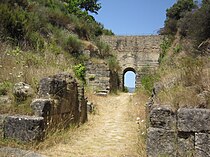
The ancient street from Greek times leads up to the northern city gate, which has been created in an artificial cut in the terrain 11 Porta Rosa, which was rediscovered by Mario Napoli around 1960.

Going under the range of hills you get to the Acropolis, the upper town. Below the modern access road to the Acropolis are the buildings of the not yet excavated 12 Südquartiers. The 1 amphitheater is embedded in the slope south of the Acropolis, of which only a few rows of seats in the west are preserved.
Right behind in the former 13 Santa Maria Church is this Antiquarium set up. In the small museum (admission included) the development phases of Elea - Velia and numerous finds from the buildings of the city are exhibited.

The path leading to the hilltop of the Acropolis leads to the 14 Cappella Palatina over that dates back to Norman times. The foundations of an ancient Greek can be found in the area of the Acropolis 15 Temple. Apart from the steps and the foundation, unfortunately nothing has been preserved that would allow conclusions to be drawn about the deity worshiped here. The entire district of the Acropolis was built over when the settlement karn reduced to this district with the decline of ancient Velia. The comes from the Middle Ages 16 Angiovini round tower and the fortress walls to secure the medieval city, under which the foundations of earlier buildings are hidden.
From the Angiovinerturm there is a magnificent panoramic view of the beach of the Cilento coast with the holiday homes of Marina di Casalvelina and Marina di Ascea.

On the way back to the entrance area, it is worth visiting the 17 Casa degli Affreschi, the building from the 2nd century. B.C. was in the 1st century A.D. remodeled, the frescoes are reminiscent of those of Pompeii.
activities
- at the near Beach from Marina di Casalvelino or Marina di Ascea you can swim after the sightseeing tour.
- The Cilento National Park invites you to go on long hikes.
shop
kitchen
nightlife
accommodation
There are no accommodations in the archaeological area itself, but there are several agroturismi, guesthouses and hotel accommodations in Ascea Marina in the vicinity.
Cheap
- 1 Alba Camping, Via Focea 2; Ascea Marina. Tel.: 0974-972331.
- 2 Camping Torre di Velia, Via Focea 1, Ascea Marina. Tel.: 39 0974 971469, Mobile: 39 346 7489558, Email: [email protected].
health
- 1 Presidio Ospedaliero "S. Luca", Via Francesco Cammarota, Vallo della Lucania. Tel.: 0974 711111.
Practical advice
There are toilets and running water in the entrance area.
There are post offices in Ascea and Ascea Marina.







